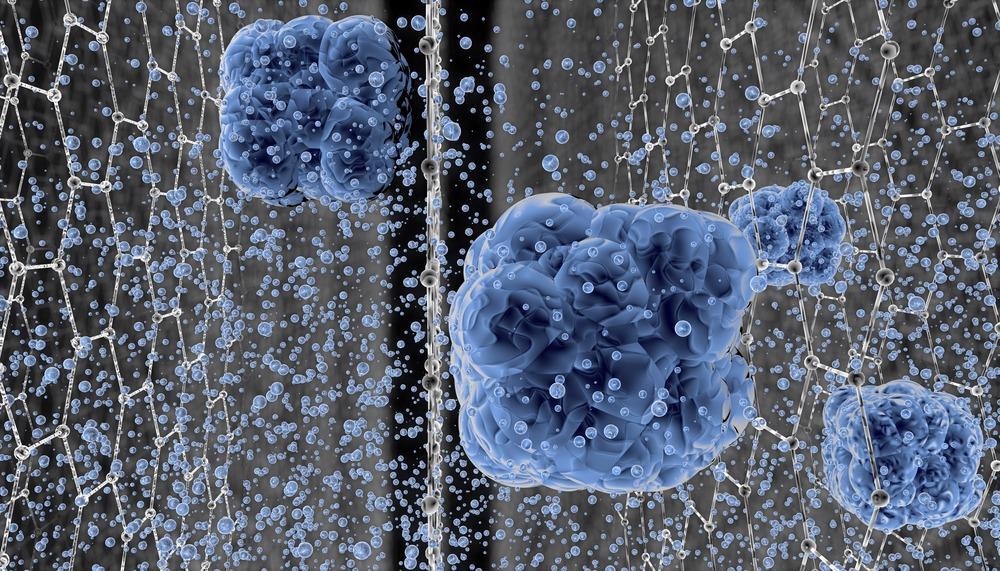Researchers have published a paper in the Journal of Molecular Liquids that systematized the origins of graphene-based nanomaterials (GBN) functionalization utilizing organic and inorganic compounds, polymeric materials, biomolecules, and anticancer medicines.

Study: Functionalisation of graphene as a tool for developing nanomaterials with predefined properties. Image Credit: Angel Soler Gollonet/Shutterstock.com
Importance of Graphene
Because of their distinctive shape as well as the physicochemical characteristics, graphene-based nanomaterials (GBN) such as graphene oxide (GO), graphene, and reduced graphene oxide (rGO) have been at the focus of study. Biomedical model development is one of the most important applications of GBN, including synthetic biology, bioimaging focused chemotherapeutic drugs transmission, bioelectronics, the advancement of antimicrobial agents, antibacterial, and fungicidal substances, and the distribution of biological molecules such as enzymes, peptides, genetic material, RNA, and DNA. Furthermore, GBN was employed as a substance for power generation (fusion reactors, cells, solar panels), smart materials manufacture, nano-enhancers to develop heat exchange medium with enhanced thermal efficiency, and water treatment and purification.
Functionalization of Graphene
Covalent and non-covalent reactions can be used to functionalize GBN. The functionalization of GBN improves its electromagnetic, photonic, thermodynamic, electrical, and physical characteristics. Graphene is a monolayer carbon-containing substance that, based on the methods of synthesis, can be formed as single or multilayered flakes.
These processes enable the creation of one-of-a-kind compounds for therapeutic systems such as cancer therapy, pharmaceutical and biomacromolecules administration, biosensor synthesis, and the processing of materials with antimicrobial, antibiotic, and antifungal characteristics.
Importance of Graphene Oxide
Like many functional groups that allow for additional surface functionalization and enhance biocompatibility, GO offers the greatest promise for use in nanomedicine. Furthermore, the inclusion of oxygen-containing functional groups improves the stability of GO microemulsions.
Graphene Conjugation with Organic Molecules
Amidation, esterification, and halogenation processes can be used to covalently or non-covalently functionalize graphene structure with organic compounds. Researchers have demonstrated covalent functionalization processes for graphene quantum dots, in which the graphene surface was functionalized with organic compounds such as dialcohols, diamines, and dithiols for bioimaging applications. The results revealed that the contact between the two dipoles (T, P) and graphene is less than the connection between the nonionic particle.
Graphene modification with Inorganic Molecules
The interface of graphene may be functionalized with inorganic molecules such as metal and metal oxide nanostructures. According to a review of the literature, GBN was non-covalently functionalized with metal nanoparticles for biomedical applications and antimicrobial purposes, such as metal nanoparticles, gold nanoparticles, and platinum nanoparticles. Furthermore, the non-covalent functionalization of GBN with metal oxide nanoparticles yields nanomaterials to create antibacterial medicinal chemistry and biological detectors for single-stranded RNA detection. Simultaneously, the covalent and non-covalent functionalization of GBN with Fe3O4 magnetic nanoparticles enables the development of nanomaterials for drug delivery and cancer sensing.
Graphene Functionalization with Polymers
Through chemical and non-covalent contacts, graphene and GO may be functionalized with various polymers. The nanoparticles developed can be employed in power generation, catalytic, and healthcare.
Researchers demonstrated the feasibility of covalently functionalizing GO with poly(vinyl alcohol) (PVA) to improve PVA's physical qualities. As a consequence, the authors observed a 60% increase in Young's modulus and a 400% increase in mechanical values in comparison to non-modified PVA. It has been established that the addition of GO to PVC reduces surface roughness by increasing contact angle values.
Graphene Incorporation in Anticancer Drugs
Through the non - covalent interactions of the medication with the graphene surface, GBN was coupled with anticancer medicines. According to the researchers, covalent functionalization of GO with sulfonic acid groups and folic acid allowed them to boost the selectivity towards MCF7 cells (human breast cancer cell line). When compared to individual medications, the integration of anticancer agents by non-covalent modification dramatically increases treatment effectiveness. The covalent modification of GO with chlorotoxin (CTX) improves medication delivery to glioma cells.
Graphene Modification with Biomolecules
Graphene and GO were covalently or non-covalently attached to chain length proteins, catalysts, and polymers. The material could be utilized to create detectors with great sensitivity to tiny molecules such as antigens. Researchers discovered that GO might be chemically coupled with polyethyleneimine to serve as a cationic vector for gene delivery. Due to its strong photoluminescence capabilities, the conjugate also served as a bioimaging material.
The researchers performed covalent and non-covalent conjugation of GBN with biomolecules such as enzymes, sugars, and pathogens for a variety of pharmaceutical applications, cancer care, synthetic biology, bioimaging, and the advancement of biomaterials for identifying very low doses of biological molecules such as nucleic acids, peptides, or proteins, particularly for disease detection.
In a nutshell, the article describes the findings of research on the covalent and non-covalent functionalization of graphene surfaces. However, a considerable number of scientific publications have been dedicated to the use of GBN as nanomodifiers. There is also a paucity of data on the identity of the synthesized nanomaterial. Another drawback is that there is no information available on the biosynthetic processes of GBN for biomedical applications. Nonetheless, this research would pave the way for future uses.
Continue reading: How Doped Graphene Could Revolutionize Next-Gen Technologies
Reference
Abdelhalim, A. O. E. et al., (2021) Functionalisation of graphene as a tool for developing nanomaterials with predefined properties. Journal of Molecular Liquids. 118368. Available at: https://www.sciencedirect.com/science/article/pii/S0167732221030932?via%3Dihub
Disclaimer: The views expressed here are those of the author expressed in their private capacity and do not necessarily represent the views of AZoM.com Limited T/A AZoNetwork the owner and operator of this website. This disclaimer forms part of the Terms and conditions of use of this website.